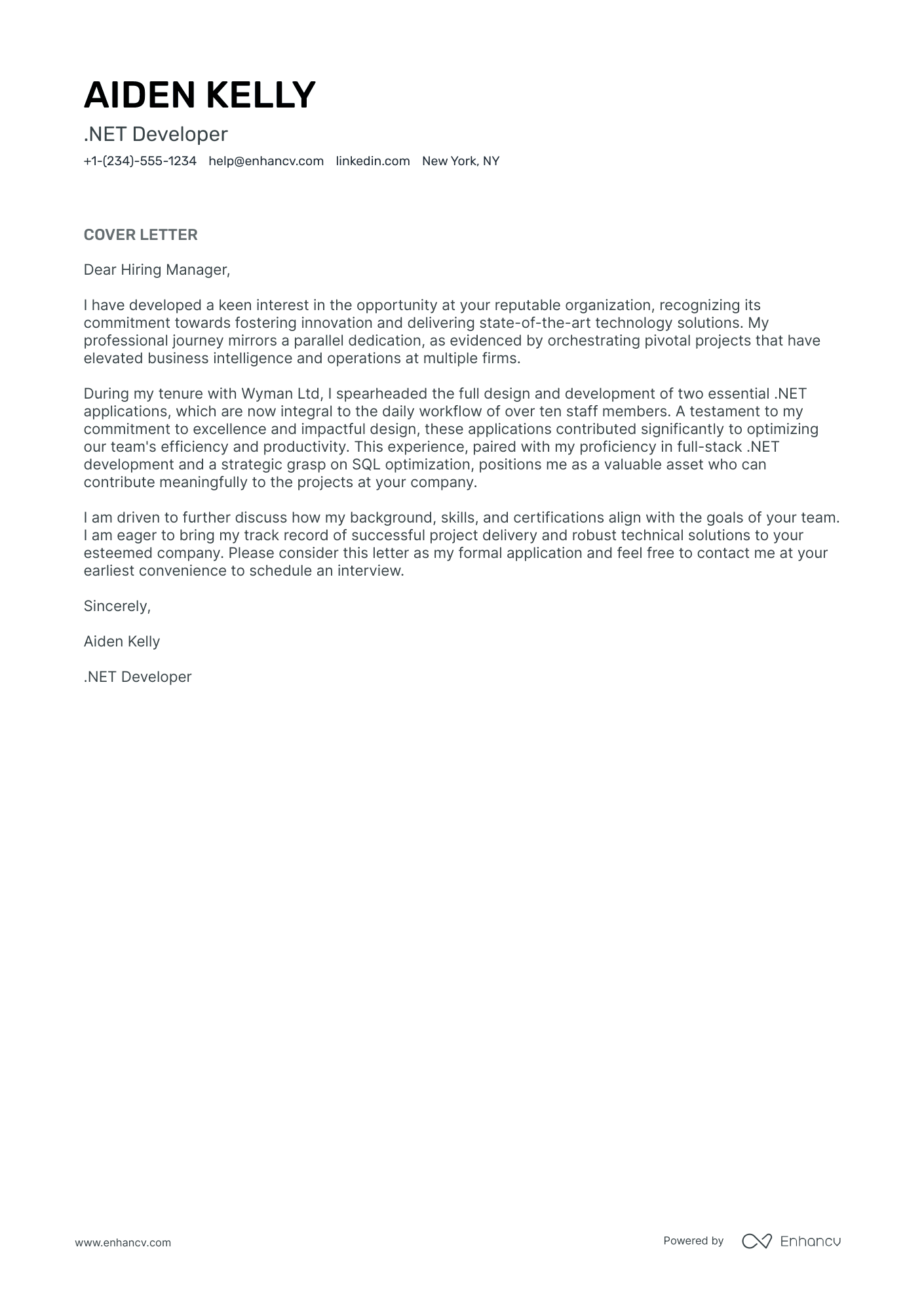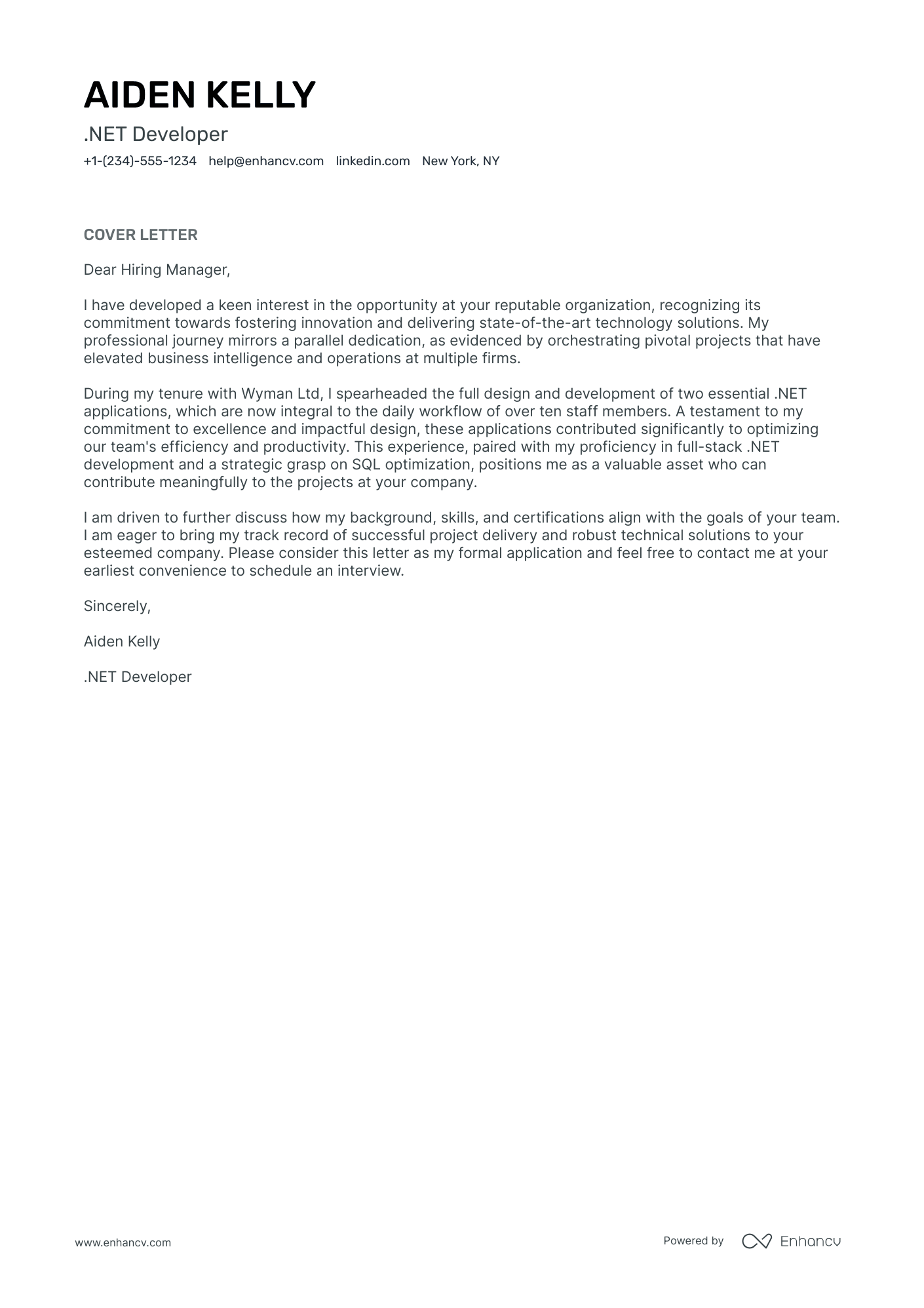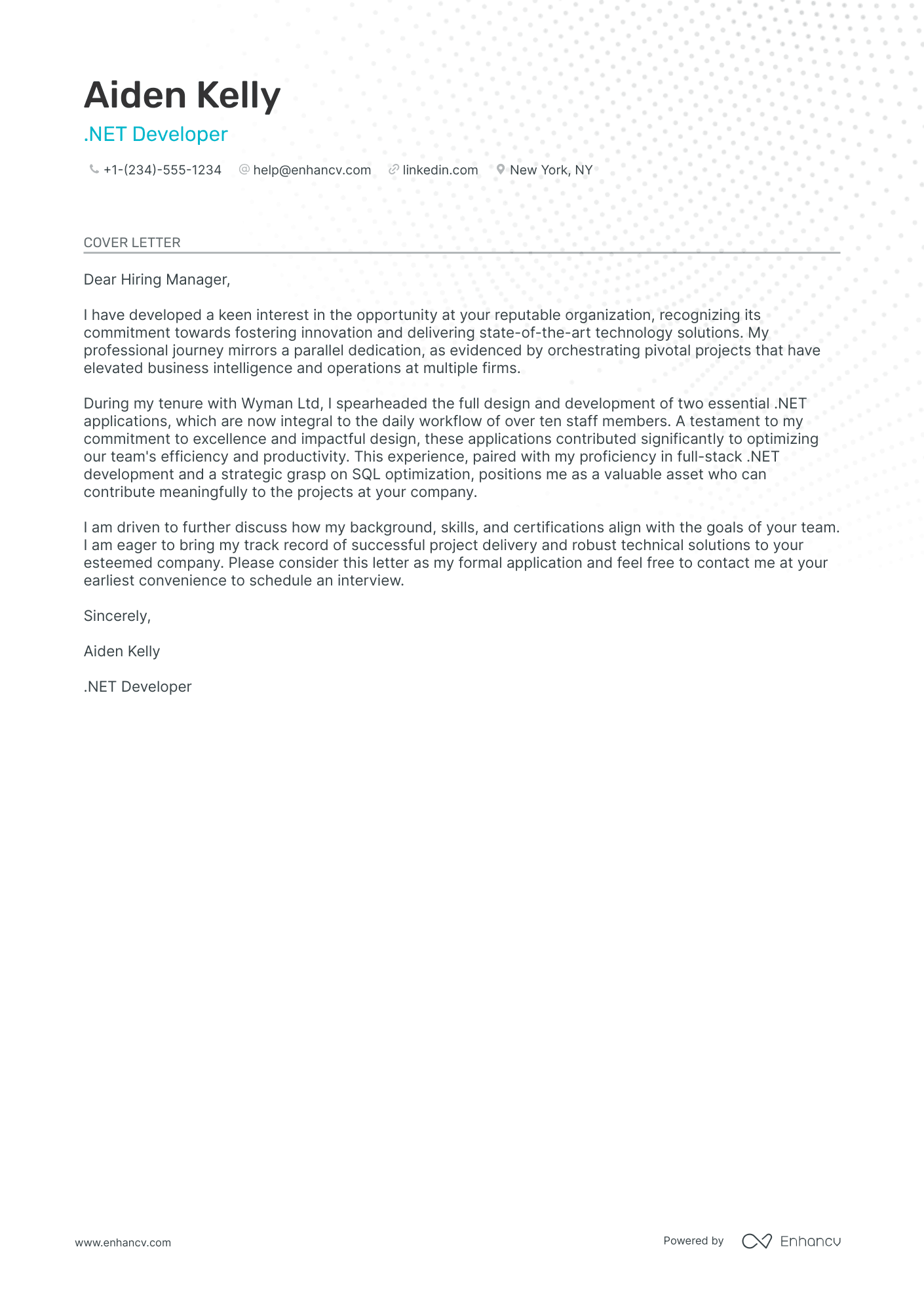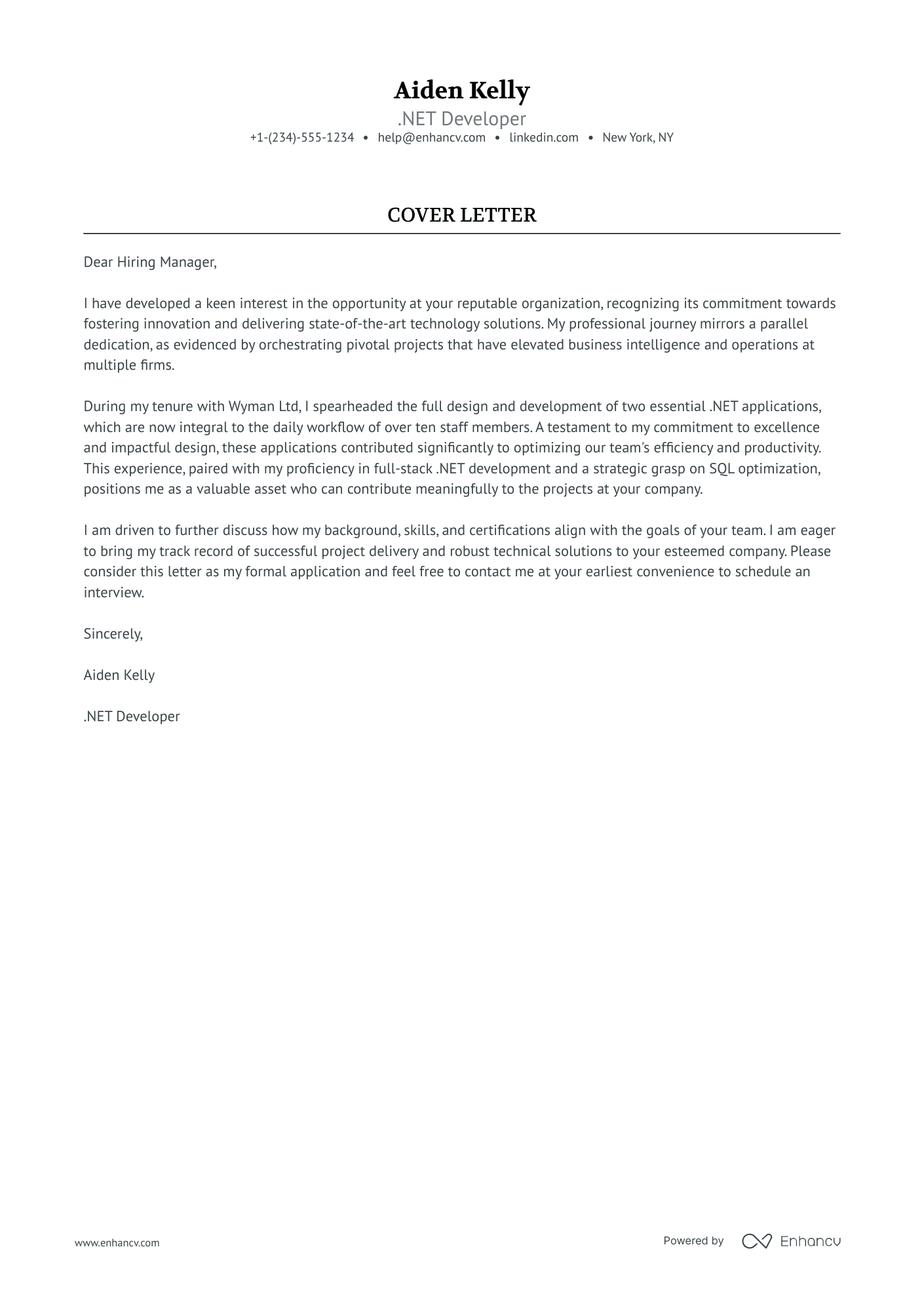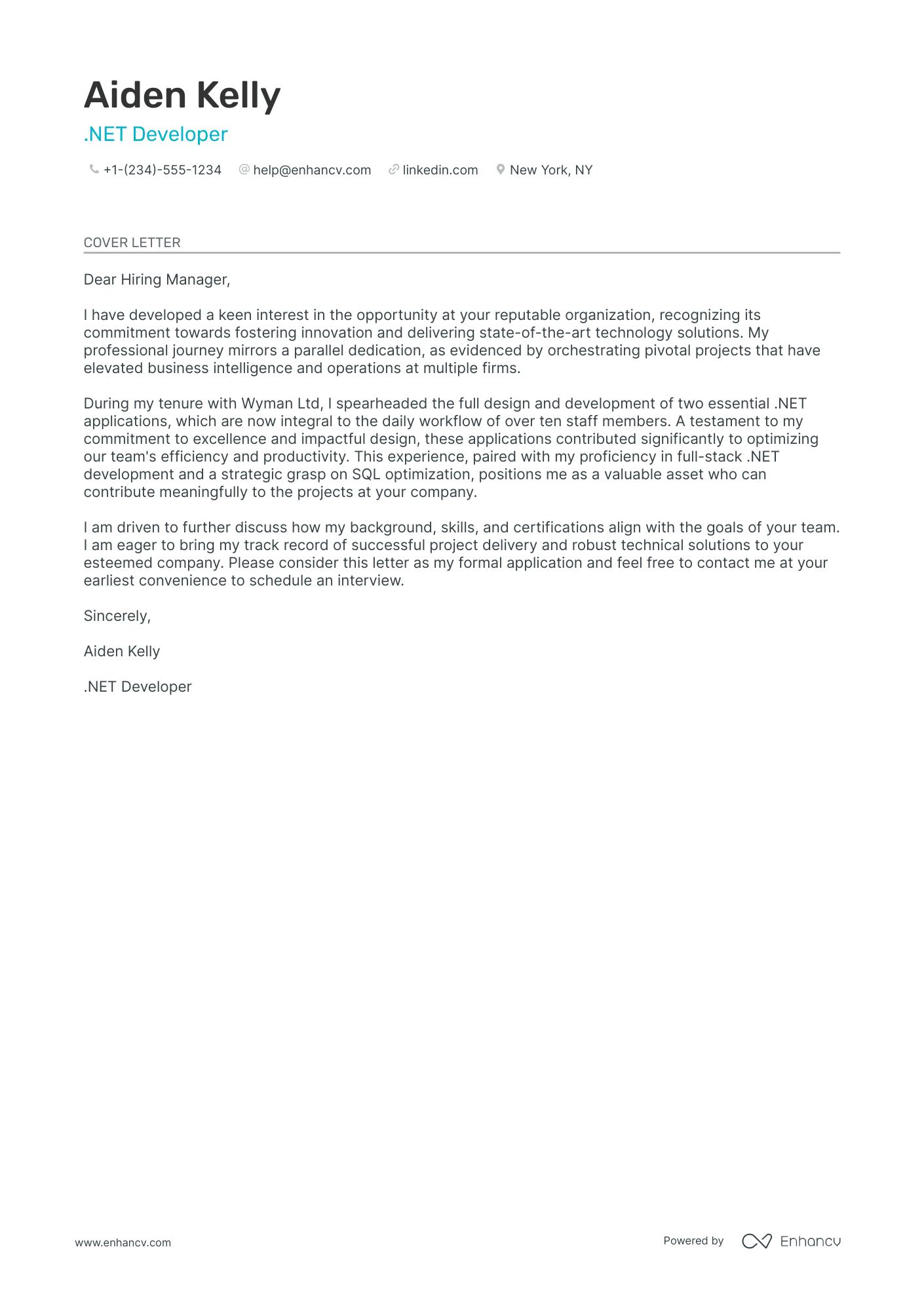Embarking on your job hunt as a .NET developer, you've likely realized the daunting task of crafting a standout cover letter—a vital piece of your application puzzle. Far from echoing your resume, your cover letter should weave a narrative around your proudest professional triumph. Striking a balance between formality and originality, minus the clichés, can be tough. Keep it concise; remember, the most compelling stories fit neatly on just one page. Let's start shaping yours.
- Create a .net developer cover letter to persuade the recruiters you're the best candidate for the role;
- Use industry-leading .net developer cover letter templates and examples to save time;
- Dedicate your .net developer cover letter space to your best achievement;
- Make sure your .net developer cover letter meets recruiters' expectations and standards.
Avoid starting at the blank page for hours by using Enhancv's AI - just upload your resume and your .net developer cover letter will be ready for you to (tweak and) submit for your dream job.
If the .net developer isn't exactly the one you're looking for we have a plethora of cover letter examples for jobs like this one:
- .Net Developer resume guide and example
- Tableau Developer cover letter example
- IT Delivery Manager cover letter example
- Web Project Manager cover letter example
- System And Network Engineer cover letter example
- Programmer cover letter example
- Cloud Network Engineer cover letter example
- AWS Developer cover letter example
- System Analyst cover letter example
- Engineering Student cover letter example
- IT System Administrator cover letter example
Drop your resume here or choose a file.
PDF & DOCX only. Max 2MB file size.
.Net developer cover letter example
Aiden Kelly
New York, NY
+1-(234)-555-1234
help@enhancv.com
- Demonstration of relevance: The cover letter specifically mentions the development of .NET applications, directly aligning with the role of a .NET Developer, which can catch the attention of the hiring manager looking for relevant experience.
- Quantifiable achievements: The applicant effectively quantifies their impact by stating the applications they developed are used by over ten staff members daily, providing concrete evidence of their work's significance.
- Technical skills emphasis: The candidate highlights their proficiency in full-stack .NET development and SQL optimization, pinpointing the technical skills most relevant for the .NET Developer position.
- Call to action: The close of the letter expresses eagerness to discuss their alignment with the company's goals, indicating readiness for the next step and facilitating action from the hiring manager.
The format of your .net developer cover letter: structure, fonts, margins, and more
Your .net developer cover letter should include a header (with your name, position, and date); a greeting and introductory paragraph; a body and closing paragraphs; and an optional signature.
Remember that you're writing your .net developer cover letter for recruiters - as the Applicant Tracker System won't scan this content.
Here are a few more tips and tricks to keep in mind when formatting your .net developer cover letter:
- Use the same font in your .net developer cover letter and resume. We recommend modern fonts, e.g. Lato and Rubik, to help you stand out, instead of the stereotypical Arial and Times New Roman.
- Each paragraph should have single spacing, which is already set up for you in our cover letter templates.
- Our cover letter builder follows industry standards for your .net developer cover letter formatting - with a one-inch margin, surrounding your content.
- Always export your .net developer cover letter in PDF to ensure the image or text quality stays the same and your writing isn't moved about.
Why spend hours writing a cover letter? Our free cover letter generator can do it for you in seconds.
The top sections on a .net developer cover letter
Header (including Contact Information): This section includes your name, professional title, address, phone number, and email, ensuring that the recruiter can quickly identify who you are and how to contact you for further discussion about the .NET developer position.
Opening Greeting: A personalized greeting to the hiring manager demonstrates your attention to detail and interpersonal skills, which are important for a .NET developer role that may involve teamwork and client interaction.
Introduction: This is where you should grab the recruiter's attention by mentioning your relevant .NET development experience and why you're interested in this specific role, which can set the tone for your application and convey your enthusiasm.
Body (highlighting .NET specific skills and experience): Use this section to detail your experience with .NET frameworks, languages (like C# or VB.NET), and any pertinent projects or accomplishments, showing the recruiter your direct qualifications and depth of knowledge in the field.
Closing Paragraph (and Call to Action): This is the final opportunity to express your desire to discuss how your .NET expertise can benefit their company, and to prompt the recruiter to invite you for an interview, leaving a professional and proactive closing impression.
Key qualities recruiters search for in a candidate’s cover letter
- Proficiency in C# and .NET framework: Demonstrates the core technical expertise necessary for building and maintaining .NET-based applications.
- Familiarity with ASP.NET MVC: Shows the ability to build web applications using the MVC design pattern, which is a prominent aspect of web development within the .NET ecosystem.
- Experience with SQL and database design: Essential for developing applications that require data persistence, which is a common requirement for enterprise applications.
- Knowledge of front-end technologies (HTML, CSS, JavaScript): Indicates a well-rounded skill set for creating full-stack applications, improving team collaboration and project versatility.
- Understanding of object-oriented programming (OOP) principles: OOP is fundamental to .NET development, vital for writing clean, modular, and maintainable code.
- Experience with DevOps tools (e.g., Azure DevOps, Git): Reflects the ability to participate in contemporary software development practices like continuous integration and delivery (CI/CD), essential for agile, team-based environments.
How to start your .net developer cover letter: with a greeting, of course
Have you ever considered just how powerful a personalized salutation can be?
We sure have news for you! Your .net developer cover letter should start with the right salutation to recruiters, nurturing a sense of respect and individuality.
Greet recruiters by using their first name (e.g. "Dear Tom" or "Dear Patricia") if you've previously established contact with them.
Otherwise, opt out for the less familiar, "Dear Ms. Peaches" or "Dear Ms Kelsey", if you've found the recruiter's name on LinkedIn or a corporate website.
"To whom it may concern" is never a good option, as it creates a sense that you've been sending out your .net developer cover letter to anyone. Instead, use "Dear HR team" or "Dear (company name) recruiter" for a feeling of exclusivity.
List of salutations you can use
- Dear Hiring Manager,
- Dear [Company Name] Recruiter,
- Dear [Hiring Manager's Name],
- Dear [Department] Team,
- Dear [Job Title] Hiring Committee,
- Esteemed [Job Title] Search Committee,
Your .net developer cover letter introduction and the value you bring
Moving on from the "Dear Recruiter" to your professional introduction.
Use those first two sentences of your .net developer cover letter to present the biggest asset you'd bring to the organization.
Don't go into too much detail about your achievement or the skill set, but instead - go straight for the win.
That is - what is your value as a professional?
Would you be able to build stronger, professional relationships in any type of communication? Or, potentially, integrate seamlessly into the team?
How to select your best achievement for the middle, or the .net developer cover letter body
You probably feel exhausted by this point in your application: you've dived into all the details of your success and skills in your .net developer resume.
What else can you include in your .net developer cover letter body?
Well, for starters, the next three to six paragraphs should show you further value as a professional. Or, why should recruiters choose you?
Think back on a noteworthy achievement that answers key job requirements and dive deep.
Structure your .net developer cover letter middle as you'd a story: following chronological logic and highlighting outcomes, thanks to skills.
At the end of the day, you'd want recruiters to be able to see you as the best candidate for the role and understand more about who you are and what makes your success unique (and valuable to the role).
Ending your .net developer cover letter to avoid "sincerely yours"
Yes, this sort of closing statement may work best before your signature.
But you want to give recruiters something more with your .net developer cover letter ending.
Some professionals choose to go down the path of promises. In a single sentence, they map out what they'd bring about to the role (whether that's a particular technical skill set or personal traits).
Others, decide to be more concrete by thanking recruiters for their time and prompting for their next interview.
Whatever path you choose, remember to always be polite and respectful of the opportunity you've had. Good manners go a long way.
Is it beneficial to mention that you have no experience in your .net developer cover letter?
Lacking professional experience isn't the end of the world for your .net developer cover letter.
Just be honest that you may not have had roles in the industry, but bring about so much more.
Like, your transferable skills, attained thanks to your whole work and life experience (e.g. the skills your summer spent working abroad taught you).
Or, focus on what makes you, you, and that one past success that can help you stand out and impress recruiters (think of awards you've attained and how they've helped you become a better professional).
Alternatively, write about your passion and drive to land the job and the unique skill set you would bring to enhance the workplace culture.
Key takeaways
Writing your .net developer cover letter has never been easier, so remember to:
- Select a .net developer cover letter template that automatically meets industry formatting (e.g. has one-inch margins, is single-spaced, is in PDF, etc.);
- Make your .net developer cover letter personal by mentioning the recruiters' first or last name;
- Within the introduction, describe what you like best about the company in no more than two sentences;
- Use your .net developer cover letter body to tell a story of your greatest achievement, backed up by job-relevant skills and technologies;
- If you have no professional experience, be honest about it in your .net developer cover letter, but also write about your unique talents.
.Net Developer cover letter examples
By Experience
Senior .Net Developer
Junior .Net Developer
By Role
